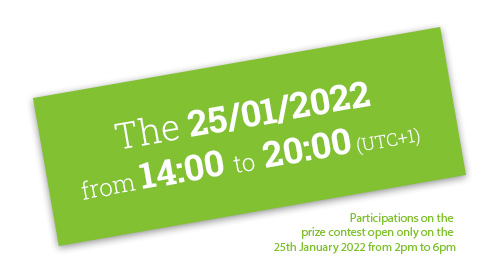Hybrid trade shows, a futureproof solution
How is society’s increasing digitalization pushing us to rethink the tools we use in the events sector?
With an average of 6 hours and 54 minutes per day spent on the internet, our consumption of the web is constantly increasing!
Like it or not, our society is undergoing a digital transition across the board: our administrative files are processed on the internet, we shop online, we receive receipts via email, and the list goes on.
Little by little, how we use the internet is evolving. The arrival of the “Metaverse” and the ensuing interest immediately shown by brands proves once again that our screens are not about to take a back seat. Innovating is the key to remaining competitive!
For the events sector, going virtual was a godsend for business during the COVID-19 crisis. When travel was restricted, the sector adapted. Digital trade shows were widespread, gaining traction thanks to their many advantages: reduced costs, simplified logistics, larger audience and accurate statistics. Virtual solutions have been embraced by organisers and attendees alike, thanks to how easy they are to access, use and engage with exhibitors.
Keep your finger on the pulse
Today, even thinking about organising an event without a virtual dimension seems like a foolhardy decision, effectively writing off a large part of the potential audience.
Events professionals have observed a fairly significant drop in attendance at face-to-face trade fairs. For example, ProWein saw a reduction of 38% in visitors this year. People are no longer willing to travel thousands of miles for a conference or tradeshow. In the age where climate change influences decision-making, behaviour is changing along with society’s standards. Many are increasingly reluctant to use heavily polluting transport to attend events, either out of ecological conviction or to avoid the inconvenience of travel.
Of course, many people still appreciate physical meetings and were looking forward to the return of face-to-face meetings when they weren’t taking place. It’s a no-brainer to combine the two into a new format with elements of digital and face-to-face meetings; this is where hybrid events come into play.
What are “hybrid” events?
Hybrid events are a combination of different forms and practices which enjoy the advantages of face-to-face and virtual events, meaning they’re both accessible and adapted to everyone’s expectations.
To go hybrid, your strategy must be adapted to your target and your sector, but it’s easy to imagine 3 options: before the event, during and/or after – the joy of hybrid is that any combination is possible. What’s more, hybrid events encourage greater inclusiveness and reduce costs without sacrificing interactivity.
For your hybrid exhibition to be successful, it can’t be thought of as a “plan B” for a physical event. Your virtual exhibition platform must be chosen with care as it will determine the success of your event. The online platform is much more than a simple extension of your digital event, it is really necessary to adopt an omnichannel vision and to take into account the whole event ecosystem.
Improve the customer experience!
Taking your face-to-face event hybrid could also help you improve the customer experience, both physically and virtually. The integration of the digital part requires the mobilisation of more people, but it offers considerable opportunities for your exhibition.
Let’s take the example of a hybrid job fair. With matchmaking, you save time and increase quality meetings between candidates and companies. The appointment booking app can facilitate both ”in person” or “online” meetings.
Visitors can access the stands in a few clicks, and also prepare for their meetings. If we take the example of the job fair, we can imagine opening the digital fair beforehand so that prospective candidates can preview offers, making appointments and preparing for the opportunities that interest them most.
By opting for an omnichannel customer experience, you maximise your chances of getting it right. It is important in hybrid events to centralise all your data and to look at it as a whole.
A hybrid trade fair for a positive customer experience!
To optimise the customer experience and make it a success, there are several elements to take into account:
- Know your customer!
Understand your attendees motivations and keep your promises. All solid relationships are built on trust and being clear about the objectives of your event with your visitors will avoid disappointment or frustration. - Keep things simple
Ensure the process to register and attend both parts of the event is as easy as possible by using a single website. The registration for the online exhibition could be set up to generate a QR code that can be scanned during the visit to the in-person exhibition. This same QR code will contain the key to the information filled in by each visitor. At our job fair example, for instance, the recruiter would simply scan the QR code to download the visitor’s CV. - Create engagement and think outside of the box
You can encourage interaction between online and face-to-face visitors by offering activities, mini-games, and speakers on the platform, which can add a lot to your event. - Don’t abandon the virtual for the face-to-face and vice versa
Online visitors should not feel left out or shunted to a secondary role: this could discourage them from attending future “online” events. They must feel that they are visitors in the same way as face-to-face visitors. To do this, it is important to mobilise exhibitors and make them aware of the importance of being proactive on both channels. - Extend the user experience
Being able to access and download content found at a face-to-face exhibition once it is over is a great advantage. The ability to replay conferences makes virtual platforms the perfect partner for physical events.
Naturally, it’s important to give your attendees an excellent experience. Thanks to word of mouth, a satisfied visitor can become your best ambassador!
What are the best practices for hybrid exhibition?
1 – Face to face events and virtual solutions are complementary: the two solutions must be linked and act as an extension of each other.
2- The communications strategy of events is extremely important. Communications and media channels must be varied. Be sure to deliver a clear message about the possibilities offered by each format. While print communication may be ideal for a physical event (bus shelters, 4×3 posters, etc.), communication for the digital edition should be adapted to the new target (social networks, email blasts, etc.). Don’t forget to send reminder emails about both of your events!
3- Pace the day with activities, conferences and highlights (e.g. you can offer a competition on site allowing in-person visitors to compete with online attendees ). Animate the digital event by pushing instant messages to visitors.
4- Equip your teams with the right technology: nothing is more frustrating than a video call with a jerky image or a conference with incessant background noise. Make sure your speakers have the necessary equipment for good communication and interaction with visitors!
5- Make it easy for visitors to navigate: choose an intuitive platform which makes sure that visitors can easily find their way around and find the information they are looking for. The structure, the content titles and spaces have to be clear. Put yourself in a visitor’s shoes and anticipate their journey to ensure everything runs smoothly.
6- Use data to understand areas for improvement: analysing the information will help you adapt to the needs and behaviours of your users. Build upon this knowledge for future events!
A hybrid trade show increases the potential audience, while maintaining the conviviality of a face-to-face event, meeting the needs of an increasingly connected population.
Do you need a solid, safe platform for your hybrid exhibition project? Let’s talk!
Some more news?
Don’t hesitate to go through our articles and detailed guides!
Event ! Discover AppyFair
AppyFair is inviting you to its own virtual fair!
Digital pollution and the use of digital in the event industry
Far from the obvious pollution generated by waste or CO2, digital pollution is not negligible.
The future of the event industry & the rise in climate change
The events sector is one of the human activities with a high carbon impact. What is the value of virtual events in terms of helping out our environment?


